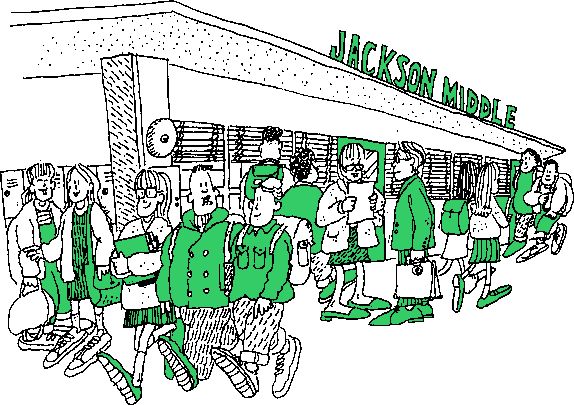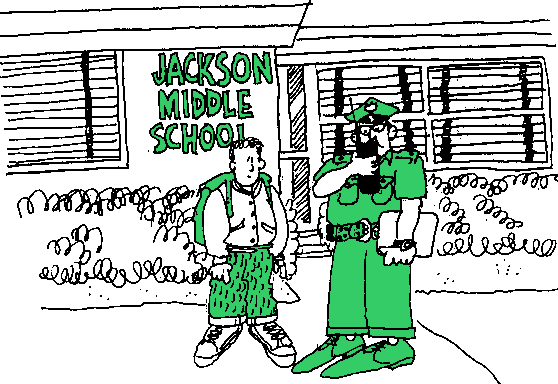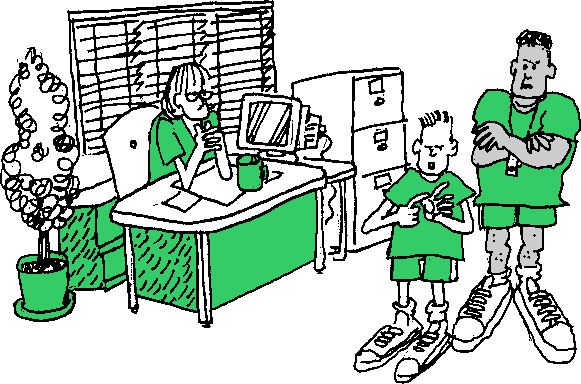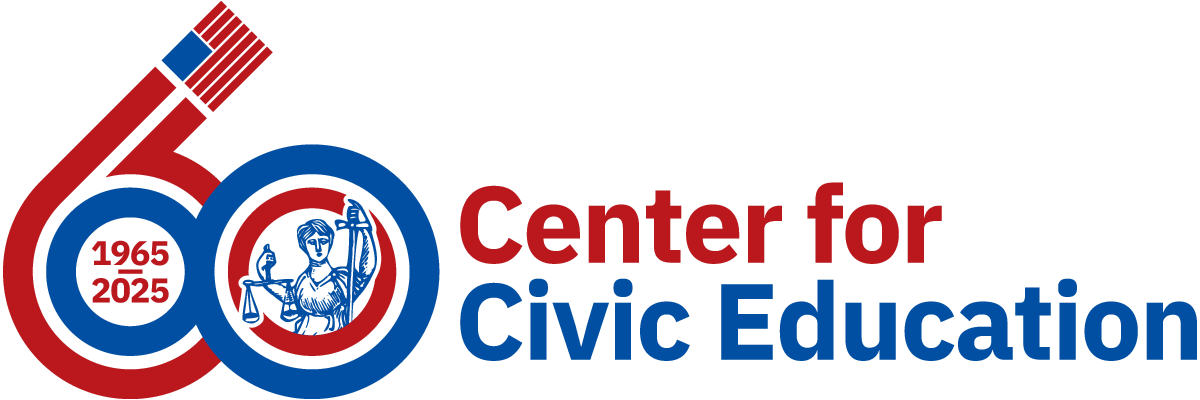|
Drugs in the Schools: Preventing Substance Abuse
Student book

Introduction to the Textbook
This program will help you to better understand a problem facing our schools today. The problem is substance abuse. We define substance abuse as the use of illegal drugs. It is also excessive use of legal substances, such as over-the-counter drugs, alcohol, and tobacco. Alcohol is an illegal substance for people under 21 years of age. Tobacco is illegal in many states for people under 18 years of age.
Many students in our nation have a problem with substance abuse. It is important for us to understand the problem. It is even more important to find ways to deal with this problem in our schools.
This program provides you the opportunity to explore the seriousness of the substance abuse problem in our schools. You will examine the problem of substance abuse at an imaginary school. We call this school Jackson Middle School. You will work with others in your class to solve some of the substance abuse problems at Jackson.
A good place to start is by examining your opinions about substance abuse. You will gather information by reading newspaper articles and doing research. You will also interview people in your school and community who understand something about the problem. When you finish your investigation, you should understand the seriousness of the problem. You also should know some causes and effects of substance abuse among young people.
Once you fully understand the problem, you are ready to create or select a solution. You also can evaluate the solutions that other schools have used. Then you are ready to develop your plan to help solve the problem at Jackson Middle School. To complete your study, you can present your plan to others in your community.
By participating in this program you learn to exercise one of your most important rights. Every citizen has a right to examine problems in society and to express his or her ideas about how we should solve them. It is our responsibility as citizens to know as much as possible about these problems and to work together to create solutions.
Lesson 5: How can Jackson Middle School meet its responsibility to deal with the problem of substance abuse?
Ms. Sage thought about what might be done to address the substance abuse problem at Jackson Middle School. First, she made a list of some responsibilities the school had in dealing with drugs, alcohol and tobacco. Here are some of the notes she wrote in her planning book.
What are the school’s responsibilities?
The purpose of school is to educate young people. To do so, schools have to provide a disciplined environment free of drugs and violence. The principal and teachers have a duty to make school a safe place. They have a duty to provide an opportunity for all students to learn. They also have to make the campus safe for others, including staff, teachers, and visitors.
On the following pages are some responsibilities schools must fulfill to ensure a good environment for all students.

- Educate all students. The school is responsible for educating all students in all school subjects, including the health and legal consequences of substance abuse.
- Provide for the health and safety of students. The school has the responsibility to protect the health and safety of the students by
- helping students who are using or abusing alcohol and other drugs.
- protecting students who do not use alcohol or other drugs from the influence of those who do.
- Enforce school rules and the laws. The school is responsible for enforcing school rules and the laws against tobacco, alcohol, and other drug use by
- discovering students who are breaking the law and informing law enforcement.
- confiscating illegal alcohol and other drugs that students might bring to school.
- disciplining students found guilty of selling, buying, or using illegal drugs.
- Protect individual rights. The school is responsible for protecting important rights such as those included in our Constitution and Bill of Rights by
- protecting privacy such as a student’s rights not to be searched or to have his or her property searched without a good reason.
- providing fair procedures and fair treatment such as making sure that
- anyone suspected or accused of using alcohol or other drugs has a fair hearing. For example, students should have the right to present their side of the story.
- anyone found guilty of having or using alcohol or other drugs receives fair treatment. For example, no one should receive a punishment that is cruel or unusual.
- anyone found guilty of having or using alcohol or other drugs receives equal treatment. For example, people who commit the same offense, generally, should receive the same consequences.
- Protect the welfare of the community. The school is also responsible for protecting the welfare of the community. The school is responsible for enforcing laws against drugs or alcohol so that the school does not create problems for the community. This includes
- ensuring that no drugs or alcohol are bought, sold, or used on or near the school campus.
- enforcing attendance laws and making sure students fulfill their responsibilities to learn and obey school rules.

In the school and community, who is responsible for Jackson Middle School’s substance abuse problem?
While Ms. Sage was writing her notes she recognized that Jackson Middle School has a number of responsibilities. She wondered if others have responsibilities, too. She thought that some problems do not begin with the school. They might start at home or in the community. This might be true of the problem with drugs and alcohol. If so, others should have responsibility for helping solve them.
Who do you think is responsible for helping solve the problem at Jackson Middle School? Explain what responsibility each might have for helping solve the problem.
| Who in the school might have responsibility for helping solve the problem? |
What responsibility might this person or group have? |
Who in the community might have responsibility for helping solve the problem? |
What responsibility might this person or group have? |
| 1. principal |
discipline |
1. lawmakers |
duty to protect children |
| 2. |
|
2. |
|
| 3. |
|
3. |
|
| 4. |
|
4. |
|
| 5. |
|
5. |
|
| 6. |
|
6. |
|
What actions have other schools taken to help them fulfill their responsibility successfully?
Ms. Sage made telephone calls to other middle school principals in the city. She also called principals in other states. She wanted to find out how they were meeting the responsibility to deal with the problem of substance abuse. Ms. Sage kept detailed notes of her conversations. She received some interesting and useful information.
The suggested actions she noted in her planning book are the following:
- Student codes of conduct establish clear and specific rules regarding alcohol and other drugs. Students who violate the rules can be sure they will receive strong consequences. Some schools test students on their understanding of the rules.
- Some schools include special study units about substance abuse in all subject areas. For example,
- science, health, and physical education students learn how drugs and alcohol affect the human body and brain.
- social studies’ students learn about drug laws and how public policies can help prevent substance abuse.
- math students find information on teen drug and alcohol use. They learn to illustrate statistics on easy-to-read graphs and charts.
- language arts students read stories about people who struggle with substance abuse. They discuss the real-life dilemmas of making personal choices.
- art students create anti-substance abuse posters. They display their work around the school.
- Many schools provide parenting classes. They teach parents and other family members about drugs and how to detect signs of drug use in their children. They train parents how to respond promptly when they observe any symptoms. They teach parents to be positive role models for their children. They encourage greater parent involvement in the school.
- All schools involve members of the community. Schools ask police to patrol the area around the school. This helps discourage drug dealers. Schools involve government agencies such as public health and juvenile justice. Community groups provide mentors, drug counselors, and speakers for assemblies and classrooms.
- Some schools create a buddy system. They pair each student with a community volunteer or with an older student in the school. This gives young people someone with whom they can share their concerns and get sound advice.
- A few schools hold an annual anti-substance abuse contest. Students create projects with a drug-free slogan. Parents, community members, and school staff evaluate the students’ work and award the best entries a prize.
- Most schools have a campus security plan. Schools install fencing around the school yard, keep exterior doors locked, and monitor bathrooms. Some schools require guests to wear badges. Some hire a campus security guard or create student patrols.
- Some schools conduct surprise locker searches. The school conducts regular searches of student lockers. They do not announce the searches in advance.
- Some schools plan after-school activities. Schools provide learning and recreation activities after school hours. These activities take place at the school or local community center.
- Many schools provide counseling services. All students have easy and confidential access to counselors. The counselors have special training. They work with young people who may become or are involved with drugs.
- Many schools provide treatment services. Students have easy and confidential access to medical care. A local health care unit or the school district provides treatment for substance abuse.
- Some schools test students for drugs. Students who participate in sports such as football or basketball must pass a confidential drug test. The test detects the presence of drugs in the body.
Which substance abuse programs can be most effective at Jackson Middle School?
Ms. Sage was pleased that she talked to the principals of other middle schools. They had a lot of useful information. She was encouraged because there were so many programs around the country. She wondered which programs might be most effective at Jackson Middle School. She knew this was a decision she should not make alone.
Ms. Sage formed a committee to evaluate these programs. She wants to know if the programs will benefit students at her school. She wants to know if a program helps the school meet its responsibility. She asked students, parents, teachers, school staff, and community members to serve on the committee.
Imagine that you are a member of Ms. Sage’s committee. Work in groups of five students. Each student in the group should represent the point of view of a different committee member. Use the chart below and on the following pages to consider the proposals for addressing the problem of substance abuse. Your teacher will tell you which proposals your group should evaluate. Decide whether you would support the recommendation and why. Explain how it can help the school fulfill its responsibilities. Identify some school resources needed to implement the program. Be prepared to share your ideas with the class.
Thinking about the lesson
- What have you learned about solutions to substance abuse in the schools?
- Summarize four programs listed in this lesson that deal with the problem of substance abuse. Write a short note to Ms. Sage explaining your opinion on the value of each. Place your opinions in order, listing the best program first.
- Searching students’ possessions remains a sensitive issue in the schools. What individual rights might be involved? Is the drug problem important enough to justify such searches? Ask your teacher to share with you the 1985 United States Supreme Court decision that addresses this issue. New Jersey v. T.L.O., 105 U.S. 733 (1985)
- Probably the most controversial program is the drug testing of students who participate in sports and other school activities. What individual rights issues does this raise? Is the drug problem important enough to justify allowing drug testing in schools? Ask your teacher to share with you a 1995 United States Supreme Court decision that addresses this issue. Veronia School District 47J v. Wayne and Judy Acton, 63 U.S. L.W. 4653 (June 26, 1995)
©Center for Civic Education. All rights reserved.
Permission is granted to freely use this information for nonprofit educational purposes only. Copyright must be acknowledged on all copies. This text was originally prepared under Grant #95-JS-FX-0023 from the Office of Juvenile Justice and Delinquency Prevention, Office of Justice Programs, US Department of Justice. Points of view or opinions in this document are those of the authors and do not necessarily represent the official position or policies of the US Department of Justice.
ISBN 0-89818-110-0 |








